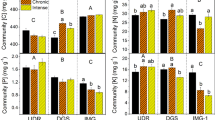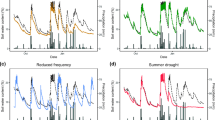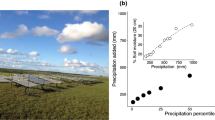Abstract
Aims
Major changes to rainfall regimes are predicted for the future but the effect of such changes on terrestrial ecosystem function is largely unknown. We created a rainfall manipulation experiment to investigate the effects of extreme changes in rainfall regimes on ecosystem functioning in a grassland system.
Methods
We applied two rainfall regimes; a prolonged drought treatment (30 % reduction over spring and summer) and drought/downpour treatment (long periods of no rainfall interspersed with downpours), with an ambient control. Both rainfall manipulations included increased winter rainfall. We measured plant community composition, CO2 fluxes and soil nutrient availability.
Results
Plant species richness and cover were lower in the drought/downpour treatment, and showed little recovery after the treatment ceased. Ecosystem processes were less affected, possibly due to winter rainfall additions buffering reduced summer rainfall, which saw relatively small soil moisture changes. However, soil extractable P and ecosystem respiration were significantly higher in rainfall change treatments than in the control.
Conclusions
This grassland appears fairly resistant, in the short term, to even the more extreme rainfall changes that are predicted for the region, although prolonged study is needed to measure longer-term impacts. Differences in ecosystem responses between the two treatments emphasise the variety of ecosystem responses to changes in both the size and frequency of rainfall events. Given that model predictions are inconsistent there is therefore a need to assess ecosystem function under a range of potential climate change scenarios.





Similar content being viewed by others
References
Allen SE (1989) Chemical analysis of ecological materials. Blackwell Scientific Publications, Oxford
Beier C, Beierkuhnlein C, Wohlgemuth T, Penuelas J, Emmett B, Körner C et al (2012) Precipitation manipulation experiments – challenges and recommendations for the future. Ecol Lett 15:899–911
Beierkuhnlein C, Thiel D, Jentsch A, Willner E, Kreyling J (2011) Ecotypes of European grass species respond differently to warming and extreme drought. J Ecol 99:703–713
Birch HF (1958) The effect of soil drying on humus decomposition and nitrogen availability. Plant Soil 10:9–31
Blankinship J, Niklaus P, Hungate B (2011) A meta-analysis of responses of soil biota to global change. Oecologia 165:553–565
Bloor JMG, Bardgett RD (2012) Stability of above-ground and below-ground processes to extreme drought in model grassland ecosystems: interactions with plant species diversity and soil nitrogen availability. Persp Plant Ecol Evol Syst 14:193–204
Borken W, Matzner E (2009) Reappraisal of drying and wetting effects on C and N mineralization and fluxes in soils. Glob Chang Biol 15:808–824
Bunemann EK, Keller B, Hoop D, Jud K, Boivin P, Frossard E (2013) Increased availability of phosphorus after drying and rewetting of a grassland soil: processes and plant use. Plant Soil 370:511–526
Butterly CR, Bunemann EK, McNeill AM, Baldock JA, Marschner P (2009) Carbon pulses but not phosphorus pulses are related to decreases in microbial biomass during repeated drying and rewetting of soils. Soil Biol Biochem 41:1406–1416
Chaer G, Fernandes M, Myrold D, Bottomley P (2009) Comparative resistance and resilience of soil microbial communities and enzyme activities in adjacent native forest and agricultural soils. Microb Ecol 58:414–424
Chaves MM, Flexas J, Pinheiro C (2009) Photosynthesis under drought and salt stress: regulation mechanisms from whole plant to cell. Ann Bot 103:551–560
Chimner RA, Welker JM (2005) Ecosystem respiration responses to experimental manipulations of winter and summer precipitation in a Mixed grass Prairie, WY, USA. Biogeochemistry 73:257–270
De Boeck HJ, Dreesen FE, Janssens IA, Nijs I (2011) Whole-system responses of experimental plant communities to climate extremes imposed in different seasons. New Phytol 189:806–817
Eade R, Hamilton E, Smith DM, Graham RJ, Scaife AA (2012) Forecasting the number of extreme daily events out to a decade ahead. J Geophys Res 117:D21110
Easterling DR, Meehl J, Parmesan C, Chagnon S, Karl TR, Mearns LO (2000) Climate extremes: observations, modelling, and impacts. Science 289:268–274
Evans SE, Byrne KM, Lauenroth WK, Burke IC (2011) Defining the limit to resistance in a drought-tolerant grassland: long-term severe drought significantly reduces the dominant species and increases ruderals. J Ecol 99:1500–1507
Fay PA, Carlisle JD, Knapp AK, Blair JM, Collins SL (2003) Productivity responses to altered rainfall patterns in a C4-dominated grassland. Oecologia 137:245–251
Fierer N, Schimel JP, Holden PA (2003) Influence of drying–rewetting frequency on soil bacterial community structure. Microb Ecol 45:63–71
Fischlin A, Midgley GF, Price JT, Leemans R, Gopal B, Turley C et al (2007) Ecosystems, their properties, goods and services. In: Parry ML, Canziani OF, Palutikof JP, Linden PJ, Hanson CE (eds) Climate Change 2007: Impacts, Adaptation and Vulnerability. Contribution of Working Group II to the Fourth Assessment Report of the Intergovernmental Panel on Climate Change, pp. 211–272
Fridley JD, Grime JP, Askew AP, Moser B, Stevens CJ (2011) Soil heterogeneity buffers community response to climate change in species-rich grassland. Glob Chang Biol 17:2002–2011
Fry EL, Manning P, Allen DGP, Hurst A, Everwand G, Rimmler M et al (2013) Plant functional group composition modifies the effects of precipitation change on grassland ecosystem function. PLoS One 8:e57027
Fry EL, Power SA, Manning P (2014) Trait-based classification and manipulation of plant functional groups for biodiversity–ecosystem function experiments. J Veg Sci 25:248–261
Gorissen A, Tietma A, Joosten NN, Estiarte M, Penuelas J, Sowerby A et al (2004) Climate change affects carbon allocation to the soil in shrublands Ecosystems 7:650–661
Heisler-White JL, Blair JM, Kelly EF, Harmoney K, Knapp AK (2009) Contingent productivity responses to more extreme rainfall regimes across a grassland biome. Glob Chang Biol 15:2894–2904
IPCC (2007) Contribution of Working Group I to the Fourth Assessment Report of the Intergovernmental Panel on Climate Change, 2007. In: Solomon S, Qin D,Manning M, Chen Z, Marquis M, Averyt KB, Tignor M, Miller HL (eds) IPCC Fourth Assessment Report: Climate Change 2007
IPCC (2013) Contribution of Working Group I to the Fifth Assessment Report of the Intergovernmental Panel on Climate Change.In: Stocker T, Dahe Q, Plattner G-K (ed) Climate Change 2013: The Physical Science Basis
ITIS (2013) Integrated Taxonomic Information System online database. Available at: www.itis.gov
Jentsch A, Kreyling J, Beierkuhnlein C (2007) A new generation of climate-change experiments: events, not trends. Front Ecol Environ 5:365–374
Jentsch A, Kreyling J, Boettcher-Treschkow J, Beierkuhnlein C (2009) Beyond gradual warming: extreme weather events alter flower phenology of European grassland and heath species. Glob Chang Biol 15:837–849
Kehl M, Everding C, Botschek J, Skowronek A (2005) Erosion processes and erodibility of cultivated soils in North Rhine-Westphalia under artificial rain–I. Site characteristics and results of laboratory experiments. J Plant Nutr Soil Sci 168:34–44
Kim JB, Verma SJ, Clement RJ (1992) Carbon dioxide budget in a temperate grassland ecosystem. J Geophys Res 97(D5):6057–6063
Knapp AK, Fay PA, Blair JM, Collins SL, Smith MD, Carlisle JD et al (2002) Rainfall variability, carbon cycling, and plant species diversity in a mesic grassland. Science 298:2202–2205
Kolari P, Pumpanen J, Kulmala L, Ilvesniemi H, Nikinmaa E, Gronholm T, Hari P (2006) Forest floor vegetation plays an important role in photosynthetic production of boreal forests. For Ecol Manag 221:241–248
Kreyling J, Beierkuhnlein C, Elmer M, Pritsch K, Radovski M, Schloter M et al (2008) Soil biotic processes remain remarkably stable after 100-year extreme weather events in experimental grassland and heath. Plant Soil 308:175–188
Laporte M, Duchesne LC, Wetzel S (2002) Effect of rainfall patterns on soil surface CO2 efflux, soil moisture, soil temperature and plant growth in a grassland ecosystem of northern Ontario, Canada: implications for climate change. BMC Ecol 2:1–10
Lee X, Wu H-J, Sigler J, Oishi C, Siccama T (2004) Rapid and transient response of soil respiration to rain. Glob Chang Biol 10:1017–1026
Lloret F, Peñuelas J, Prieto P, Llorens L, Estiarte M (2009) Plant community changes induced by experimental climate change: seedling and adult species composition. Perspect Plant Ecol Evol Syst 11:53–63
Lloret F, Escudero A, Iriondo JM, Martínez-Vilalta J, Valladares F (2012) Extreme climatic events and vegetation: the role of stabilizing processes. Glob Chang Biol 18:797–805
Maestre FT, Bowker MA, Escolar C, Puche MD, Soliveres S, Maltez-Mouro S et al (2010) Do biotic interactions modulate ecosystem functioning along stress gradients? Insights from semi-arid plant and biological soil crust communities. Phil Trans B Biol Sci 365:2057–2070
Menzel A, Sparks TH, Estrella N, Koch E, Aasa A, Ahas R et al (2006) European phenological response to climate change matches the warming pattern. Glob Chang Biol 12:1969–1976
Morecroft MD, Masters GJ, Brown VK, Clarke IP, Taylor ME, Whitehouse AT (2004) Changing precipitation patterns alter plant community dynamics and succession in an ex-arable grassland. Funct Ecol 18:648–655
Murphy J, Sexton D, Jenkins G, Boorman P, Booth B, Brown K et al (2009) UK climate projections science report: climate change projections. Met Office Hadley Centre, Exeter
Nakićenović N, Swart R (eds) (2000) Emissions scenarios: a special report of working group III of the intergovernmental panel on climate change. Cambridge University Press, Cambridge
Pimm SL (1984) The complexity and stability of ecosystems. Nature 307:321
Pinheiro JC, Bates DM (2000) Mixed-effects models in S and S-PLUS. Springer, New York
R Development Core Team (2009) R: A Language and Environment for Statistical Computing. Vienna, Austria
Reynolds JF, Kemp PR, Ogle K, Fernández RJ (2004) Modifying the ‘pulse-reserve’ paradigm for deserts of North America: precipitation pulses, soil water, and plant responses. Oecologia 141:194–210
Rice C, Pancholy S (1972) Inhibition of nitrification by climax ecosystems. Am J Bot 59:1033–1040
Rodwell JS (Ed) (1992) British Plant Communities. Volume 3. Grassland and montane communities. Cambridge University Press
Saxton KE, Rawls WJ (2006) Soil water characteristic estimates by texture and organic matter for hydrologic solutions. Soil Sci Soc Am J 70:1569–1578
Saxton KE, Rawls WJ, Romberger JS, Papendick RI (1986) Estimating generalised soil-water characteristics from temperature. Soil Sci Soc Am J 50:1031–1036
Schwinning S, Sala OE (2004) Hierarchy of responses to resource pulses in arid and semi-arid ecosystems. Oecologia 141:211–220
Shannon CE, Weaver W (1963) The mathematical theory of communication. University Illinois Press, USA
Smith MD (2011a) An ecological perspective on extreme climatic events: a synthetic definition and framework to guide future research. J Ecol 99:656–663
Smith MD (2011b) The ecological role of climate extremes: current understanding and future prospects. J Ecol 99:651–655
Sponseller RA (2007) Precipitation pulses and soil CO2 flux in a Sonoran Desert ecosystem. Glob Chang Biol 13:426–436
St Clair SB, Sudderth EA, Fischer ML, Torn MS, Stuart SA, Salve R et al (2009) Soil drying and nitrogen availability modulate carbon and water exchange over a range of annual precipitation totals and grassland vegetation types. Glob Chang Biol 15:3018–3030
Stampfli A, Zeiter M (2008) Mechanisms of structural change derived from patterns of seedling emergence and mortality in a semi-natural meadow. J Veg Sci 19:563–574
Sternberg M, Brown VK, Masters GJ, Clarke IP (1999) Plant community dynamics in a calcareous grassland under climate change manipulations. Plant Ecol 143:29–37
Turner BL, Haygarth PM (2001) Biogeochemistry: phosphorus solubilization in rewetted soils. Nature 411:258
Vogel A, Fester T, Eisenhauer N, Scherer-Lorenzen M, Schmid B, Weisser WW, Weigelt A (2013) Separating drought effects from roof artifacts on ecosystem processes in a grassland drought experiment. PLoS One 8:e70997
Wagner S, Madsen P, Ammer C (2009) Evaluation of different approaches for modelling individual tree seedling height growth. Trees Struct Funct 23:701–715
Wiegand T, Snyman HA, Kellner K, Paruelo JM (2004) Do grasslands have a memory: modelling phytomass production of a semiarid South African grassland. Ecosystems 7:243–258
Xu LK, Baldocchi DD, Tang JW (2004) How soil moisture, rain pulses, and growth alter the response of ecosystem respiration to temperature. Global Biogeochem Cy 18:GB4002
Acknowledgments
ELF was funded by a PhD studentship from the Grantham Institute for Climate Change at Imperial College, London URL http://www3.imperial.ac.uk/climatechange. The authors also gratefully acknowledge funding from UK POPnet, Centre for Population Biology and the UK Big Lottery Fund. We also thank C. Tang for help with figure preparation, and five anonymous reviewers whose insights have considerably strengthened the paper.
Author information
Authors and Affiliations
Corresponding author
Additional information
Responsible Editor: Katja Klumpp..
Electronic supplementary material
Below is the link to the electronic supplementary material.
ESM 1
(DOCX 979 kb)
Rights and permissions
About this article
Cite this article
Fry, E.L., Manning, P. & Power, S.A. Ecosystem functions are resistant to extreme changes to rainfall regimes in a mesotrophic grassland. Plant Soil 381, 351–365 (2014). https://doi.org/10.1007/s11104-014-2137-2
Received:
Accepted:
Published:
Issue Date:
DOI: https://doi.org/10.1007/s11104-014-2137-2




